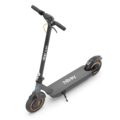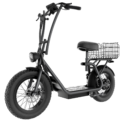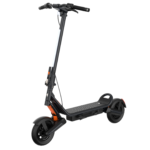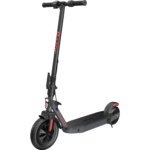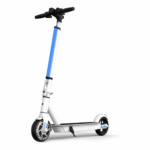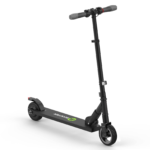- Home
- Scooters
- Electric Scooters
- Hiboy TITAN
Hiboy TITAN


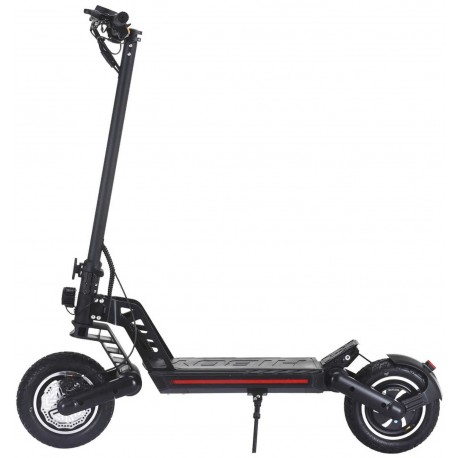
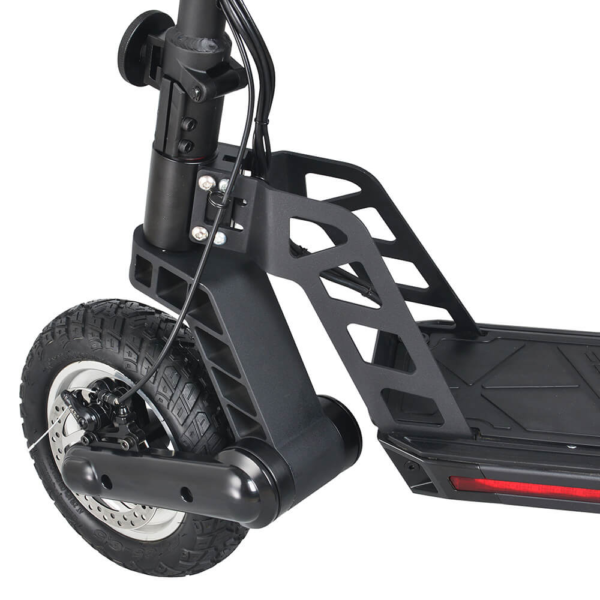
- Battery Range: 46 miles (74 km)
- Top Speed: 25 mph (40 km/h)
- Motor Power: 750 W
- Weight Capacity: 300 lb (120 kg)
- Charging Time: ~6.5–7.5 h
- Scooter Weight: 77.1 lb (35.0 kg)
PROS
- Dual hydraulic brakes
- Front & rear suspension
- 10″ gel-filled tubeless tires
- 48V 18Ah battery (21700 cells)
- IPX4 scooter / IPX5 battery
CONS
- Heavy for a single-motor scooter
- No mobile app listed
- Folded dimensions not fully specified
Table of contents
- What Is the Hiboy TITAN?
- How the Hiboy TITAN Works
- Key Specifications
- Design & Build Quality
- Performance Fundamentals
- Battery, Range & Efficiency
- Ride Quality & Comfort
- Braking & Safety Features
- Portability & Daily Usability
- Maintenance & Care
- Weather & Seasonal Considerations
- Hiboy TITAN vs Alternatives
- Who the Hiboy TITAN Is (and Isn’t) For
- FAQs
- Glossary
- Final Thoughts
Electric scooter riders who want a tougher, more capable ride often look beyond slim commuter models. The Hiboy TITAN targets that sweet spot between daily practicality and all-terrain fun. It blends a robust frame, off-road-ready tires, and confident brakes with a manageable weight and foldable design. Consequently, if you commute on mixed surfaces, climb moderate hills, or want a scooter that feels planted at speed, the Hiboy TITAN is built to suit you.
What Is the Hiboy TITAN?
The Hiboy TITAN is a mid-power electric scooter designed for city streets, park paths, and light off-road detours. It sits above compact commuter scooters in size and capability, yet it remains easier to carry than bulky performance machines. Moreover, the wide deck and dual suspension deliver a stable stance, while the 10-inch all-terrain pneumatic tires add grip and comfort on rougher pavement.
Unlike ultra-light campus scooters, the Hiboy TITAN emphasizes control. The cockpit is simple, the display is clear, and the mechanical disc brakes provide predictable stopping power. In addition, the foldable stem lets you stow it at home or office without wrestling a giant frame. Therefore, you can ride to work during the week and explore on weekends with the same scooter.
Importantly, the Hiboy TITAN focuses on usable speed and range instead of headline stats. In daily riding, it accelerates smoothly, cruises calmly, and manages hills up to moderate grades without drama. As a result, its balance often matters more than raw peak numbers.
How the Hiboy TITAN Works
Motor & Controller. A brushless hub motor drives the rear wheel, which keeps the front end light and the rear planted under throttle. Power delivery flows through a 48-volt controller tuned for steady starts and predictable roll-on. Because the controller ramps current smoothly, the scooter avoids jerky launches. New riders appreciate that. Even so, experienced riders still get a strong mid-range surge for merging or short hill sprints.
Battery & Power Path. The lithium-ion pack feeds the controller through protected wiring and a fused harness. When you open the throttle, the controller modulates voltage and current to the motor. Consequently, the motor produces torque without cogging or chatter. On climbs, it holds speed longer than smaller commuters. On flats, it maintains a sensible pace while conserving energy.
Throttle & Modes. A thumb throttle on the right side commands acceleration. Three speed modes cap the top speed as needed. In practice, Mode 1 feels relaxed for shared paths, Mode 2 suits most city cruising, and Mode 3 unlocks the scooter’s full pace. Additionally, cruise control can hold a steady speed after a few seconds, which reduces thumb fatigue on longer rides.
Brakes & Safety Cutoff. Dual mechanical disc brakes slow the Hiboy TITAN with a firm, linear feel. The system also triggers an electronic cut-off, so power drops as you pull the levers. Therefore, stopping distances shorten and the chassis stays settled. Because the brake levers bite after a modest pull, you can modulate them even with gloves.
Key Specifications
Values show manufacturer ratings where applicable. Additionally, dual-unit formatting helps you compare at a glance. The official specifications below anchor setup and maintenance choices.
General
| Item | Value |
|---|---|
| Model | Hiboy TITAN (all-terrain electric scooter) |
| Intended Use | Urban commuting, light off-road, mixed surfaces |
| Water Resistance | IP54 (dust/splash resistant) |
| Max Rider Weight | 286 lb (130 kg) |
Performance & Power
| Item | Value |
|---|---|
| Motor | 800 W rear brushless hub (peak higher) |
| Top Speed (rated) | Up to ~25 mph (≈ 40 km/h) |
| Hill Climb (rated) | Up to ~20% grade (≈ 11°), rider and terrain dependent |
| Drive | Rear-wheel drive |
Battery, Charging & Electrical
| Item | Value |
|---|---|
| Battery Pack | 48 V, 12.5 Ah lithium-ion (≈ 600 Wh) |
| Rated Range | Up to ~28 miles (≈ 45 km) in ideal conditions |
| Charger | 54.6 V, 2 A |
| Charge Time | About 6–8 hours |
| Charging Port | Single, rubber-capped |
| Operating Temp (typical) | 14–104 °F (−10–40 °C) |
Build & Dimensions
| Item | Value |
|---|---|
| Frame | Aluminum alloy with reinforced stem |
| Tires | 10 × 2.6 in pneumatic, all-terrain tread (≈ 254 × 66 mm) |
| Suspension | Dual spring (front and rear) |
| Brakes | Dual mechanical disc + electronic cut-off |
| Unfolded Size (L × W × H) | ≈ 47.2 × 24.4 × 47.2 in (≈ 120 × 62 × 120 cm) |
| Folded Size (L × W × H) | ≈ 47.2 × 24.4 × 20.9 in (≈ 120 × 62 × 53 cm) |
| Weight | ≈ 50 lb (≈ 23 kg) |
| Deck Width × Length | ≈ 7.9 × 19 in (≈ 20 × 48 cm) |
Safety & Control
| Item | Value |
|---|---|
| Lights | Front LED headlight; rear LED brake/taillight |
| Reflective Elements | Side reflectors on deck/stem |
| Bell | Handlebar bell |
| Speed Modes | 3 selectable modes |
| Display | LCD speedometer with battery and mode indicators |
Features & Extras
| Item | Value |
|---|---|
| Cruise Control | Yes (engages after holding steady throttle) |
| Fold Mechanism | Stem latch with safety catch |
| Kickstand | Side-mount |
| Hand Grips | Textured, lock-on style |
| App | Not required for core functions |
Warranty & Compliance
| Item | Value |
|---|---|
| Warranty | Manufacturer warranty on major components; battery coverage typically shorter |
| Safety Compliance | Consumer electronics safety standards; charger typically safety-listed |
| Manual & Support | Printed quick-start plus online resources |
These specifications inform sizing, maintenance intervals, and realistic ride planning.
Design & Build Quality
The Hiboy TITAN looks purposeful. The frame uses thick tubing and a braced stem to reduce flex. You feel that solidity the first time you roll over a patch of broken asphalt. Furthermore, the deck is wide enough for a natural stance, and its grippy surface keeps your shoes planted in the wet. Because the deck edges taper slightly, your calves have room during tighter turns.
Up front, the stem houses the folding latch and secondary safety catch. The latch closes with a positive snap, and the safety keeps the stem locked if the main lever loosens. While every fold system benefits from routine checks, this one inspires confidence. Likewise, the cockpit remains tidy, with a simple LCD in the center, a thumb throttle to the right, and brake levers at both grips. The cables route cleanly and avoid knee contact during hard stops.
Fit-and-finish presents well for this class. Fasteners sit flush, fenders align over the tires, and the deck rubber meets the edges without gaps. Additionally, because the scooter uses pneumatic tires, the wheel hubs and bead seats feel sturdy, not flimsy. Over time, keep an eye on the stem clamp bolts and the brake caliper mounts. A quick quarterly torque check goes a long way.
Performance Fundamentals
On level ground, the Hiboy TITAN delivers brisk but friendly acceleration. It does not leap forward at the first twitch of your thumb. Instead, it rolls on with a rising push that makes traction easy to manage. This tuning helps in wet weather and on loose shoulder gravel, where abrupt torque can spin the rear tire. From a walking start, it reaches a comfortable cruise within seconds, and it holds that speed with minimal hunting.
At 15–20 mph (24–32 km/h), the scooter feels calm. The dual springs and the soft tire casing soak up cracks that would jolt stiffer models. Meanwhile, the long deck lets you shift a foot fore or aft to balance bumps. On rougher streets, a light bend in the knees smooths out chatter. Above ~20 mph (~32 km/h), the chassis remains composed in straight lines. If you relax your hands, the stem tracks true rather than twitching. Consequently, stability builds rider confidence.
Hill starts on 7–10% grades demand more throttle, yet the Hiboy TITAN stays predictable. You may hear the motor load up as it digs in, but it does not bog or surge. On sustained grades, speed drops gradually, which gives you time to adjust your stance and mode. Because the controller delivers torque smoothly, traction stays consistent across concrete seams or shallow gravel patches. Therefore, climbs feel steady rather than frantic.
Battery, Range & Efficiency
Manufacturer range ratings assume a light rider, mild temperatures, gentle speeds, and smooth surfaces. Real life is messier. In mixed urban riding with rolling terrain, riders often see a practical range closer to two-thirds to three-quarters of the sticker value. Heavier riders, colder temperatures, and higher speeds reduce range further. Conversely, slower cruising, warm weather, and clean pavement stretch it.
For the Hiboy TITAN, treat the rated ~28 miles (≈ 45 km) as a best-case baseline. Then plan your day around a conservative working range. Begin rides near 100% state of charge and finish with at least 15–20% remaining. That buffer protects the pack from deep discharge and supports longer cycle life. Also, avoid leaving the battery at 100% for many days. Instead, charge to full the night before a long ride, or stop around 80–90% for routine commuting when range allows.
Charging practices matter. Use the supplied charger on a stable outlet. Allow the pack to cool for 30 minutes after a hard ride before charging. Likewise, let it warm up if you came in from sub-freezing weather. Because lithium-ion chemistry dislikes extremes, you will notice better range and reduced voltage sag in mild temperatures. If you store the scooter for weeks, leave the battery around 50–70% and check it monthly. Ultimately, these simple habits preserve capacity and keep performance consistent.
Ride Quality & Comfort
Ride quality starts with tires. The Hiboy TITAN uses 10-inch pneumatic tires with a supple casing and a tread that grips on dusty pavement. At correct pressure, they add compliance without feeling squirmy in corners. Under-inflated tires invite pinch flats and vague steering, so check pressure weekly. Over-inflated tires bounce and transmit vibration, which fatigues your hands and reduces traction on imperfect surfaces. Accordingly, aim for a middle ground suited to your weight—usually in the low-to-mid 40 psi range—and adjust after a few rides.
Suspension tuning favors comfort. The front and rear springs track pavement seams and expansion joints with a gentle stroke, rather than a harsh kick. Additionally, the longer deck and rear-biased drive help the chassis stay level under throttle. In steady crosswinds, the scooter holds line with only small steering inputs. On brick or cobblestone, you will still feel the pattern, yet the impacts are damped rather than sharp. As a result, fatigue builds more slowly on longer rides.
Ergonomics are straightforward. The bar height fits most riders between about 5’5″ and 6’2″ (165–188 cm). The grip angle supports a neutral wrist. Because the deck is wide, you can stagger your feet and rotate hips as you corner. The stem shows minimal twist if you brace the front wheel and wiggle the bar. Any scooter can loosen over time, but the TITAN’s hardware resists play with routine checks. Therefore, steering stays precise and predictable.
Braking & Safety Features
Braking confidence changes how you ride. With dual mechanical discs, the Hiboy TITAN offers strong initial bite and steady build-up. On clean pavement, a two-finger pull is enough for firm deceleration. On wet roads, use both brakes with a touch more front bias. The electronic cut-off helps by dropping power as soon as you squeeze the levers. Consequently, you won’t fight the motor during emergency stops.
Lighting matters after dusk. The front LED throws a crisp beam that announces your presence and helps you scan for potholes. The rear light brightens under braking, which alerts traffic. Additionally, side reflectors add passive visibility at intersections. Because the scooter carries an IP54 rating, it shrugs off puddle spray and light rain. Nevertheless, slow down on painted lines and metal grates. Traction changes fast in the wet.
The bell, reflectors, and stable chassis round out the package. You can thread through slow traffic without twitchiness, then square up the scooter and brake in a straight line. Overall, that consistency keeps surprises rare and reactions calm.
Portability & Daily Usability
Daily use depends on weight, folded size, and how quickly you can pack up. The Hiboy TITAN folds with a lever and safety catch near the base of the stem. Once folded, it lies compact enough to slide behind a desk or into a trunk. The carry weight sits around 50 lb (≈ 23 kg), which is manageable for short stair climbs but heavy for long hauls. Accordingly, plan your route to include ramps or elevators when you can.
At home, pick a charging spot with ventilation and away from clutter. Keep the charger off the floor to avoid kicks and spills. Because the charger’s LED shifts color as it finishes, you can see status at a glance. In a shared office, charge during low-traffic hours so cables don’t become trip hazards. Meanwhile, consider a small mat under the scooter to catch water after wet rides.
Security takes layers. A solid U-lock or a hardened chain lock around a fixed object deters casual thieves. Quick-release components like a seat (if installed) and phone mount should come with you. Consider a discreet cover indoors to reduce attention. Finally, note your scooter’s serial number and keep photos of unique marks. Therefore, documentation is ready if you ever need to identify it.
Maintenance & Care
Reliable scooters stay safe with simple routines. The Hiboy TITAN responds well to a light but regular schedule:
Before each ride (30–60 seconds).
- Check tire pressure; adjust as needed.
- Squeeze both brakes to confirm firm lever feel.
- Glance at the folding latch and safety catch.
- Tap the headlight and tail light to verify operation.
Weekly (10 minutes).
- Inspect brake pads; center the calipers if you hear rub.
- Wipe the deck and stem to remove grit.
- Check chain of fasteners: stem clamp, axle nuts, caliper bolts.
- Spin each wheel and listen for scraping or wobble.
Monthly (20 minutes).
- Torque the stem clamp bolts to spec.
- Clean and lightly lube the brake cables.
- Check tread wear and sidewalls for cuts.
- Review the manual for any updated recommendations.
Seasonal (30–40 minutes).
- Deep-clean frame, deck, and fork crown.
- Inspect the folding hinge for play; adjust the latch if needed.
- Examine the charger cable and port cap.
- Balance charge the pack if the scooter sat for many weeks.
Software and app habits are minimal, since the TITAN does not rely on an app for core operation. That simplicity benefits long-term reliability. Consequently, you can focus on mechanical basics and battery health rather than firmware tweaks. As always, keep your purchase documentation and warranty terms handy to streamline service if required.
Weather & Seasonal Considerations
Weather influences grip, visibility, and range. The Hiboy TITAN can handle wet streets, yet you should dial back speed and increase following distance in rain. Painted crosswalks, leaf mulch, and steel plates become slick. Brake earlier and straighten the bars before heavy lever pulls. After a rain ride, dry the scooter, especially around the folding latch and brake hardware. Otherwise, trapped moisture invites corrosion.
Cold weather reduces battery output. Below about 40 °F (≈ 4 °C), voltage sags more under load, and range shrinks. Plan shorter rides and consider a lower speed mode. Store and charge the scooter indoors near room temperature to help the pack recover. Hot weather brings different challenges. Above 95 °F (≈ 35 °C), avoid parking in direct sun. Heat accelerates battery wear and softens rubber. Thus, shade and airflow matter.
Wind also changes ride feel. A headwind reduces range, while a crosswind pushes on your torso. Bend elbows and knees to lower your profile and keep the scooter planted. If gusts get strong, slow down and give yourself more room. Overall, patience pays off when conditions shift.
Hiboy TITAN vs Alternatives
Riders often compare the Hiboy TITAN against three broad segments:
Compact commuter class.
Slim commuters like the Hiboy S2 weigh less and fold smaller. They shine for short multi-modal trips and quick indoor storage. However, they usually offer less comfort over broken pavement and less braking power. If your route includes rough edges, the TITAN’s suspension and tires win.
High-performance class.
Big scooters with dual motors sprint harder and carry more speed on steep hills. They also weigh more, cost more, and demand bigger storage. By contrast, the Hiboy TITAN delivers enough pace for urban limits while remaining easier to manage on stairs and in apartments.
Off-road-leaning class.
Knobby-tire scooters with extended travel soak up trails but can feel vague on smooth tarmac. The TITAN’s all-terrain tires strike a balance. You get bite on sand-dusted paths without sacrificing cornering feel on city streets. Therefore, it bridges weekday commuting and weekend exploring.
In short, the Hiboy TITAN excels when you want comfort and control in a package you can still carry, store, and maintain without fuss.
Who the Hiboy TITAN Is (and Isn’t) For
Great for:
- Commuters riding 5–12 miles (8–20 km) a day on mixed surfaces.
- Students who need stability and braking confidence, not just low weight.
- Recreational riders who explore park paths and waterfronts on weekends.
- Suburban riders facing moderate hills and variable pavement.
Probably not for:
- Ultralight multi-modal commuters who carry scooters several floors daily.
- Speed chasers who want extreme acceleration or 30+ mph cruising.
- Riders who refuse to check tire pressure or adjust brakes from time to time.
If you value comfort, predictable control, and a sturdy build more than headline extremes, the Hiboy TITAN lands in your wheelhouse. Moreover, it rewards consistent upkeep with consistent performance.
FAQs
1) How fast does the Hiboy TITAN go?
The manufacturer rates it up to about 25 mph (≈ 40 km/h). Actual top speed varies with rider weight, terrain, and temperature.
2) What is the real-world range?
Plan for roughly two-thirds to three-quarters of the rated ~28 miles (≈ 45 km) in mixed conditions. Slower speeds, warmer temps, and smooth pavement extend range.
3) Can I ride the TITAN in the rain?
Yes, cautiously. It carries an IP54 rating for splashes and light rain. Reduce speed, brake earlier, and dry the scooter after wet rides.
4) Does the Hiboy TITAN have cruise control?
Yes. Hold a steady throttle for several seconds and cruise control will engage. Tap the brake or change throttle to cancel.
5) What tire pressure should I run?
Start in the low-to-mid 40 psi range and adjust for weight and comfort. Check weekly. Under-inflation risks pinch flats; over-inflation reduces grip.
6) What is included in the Hiboy TITAN warranty?
The scooter carries a manufacturer warranty on major components, with the battery typically covered for a shorter period. Keep your proof of purchase for service.
7) Where can I find a concise Hiboy TITAN overview?
Right here. This guide summarizes the model’s purpose, key features, riding behavior, care tips, and the most important specifications in one place.
Glossary
Amp-hour (Ah). A measure of battery capacity. Higher Ah suggests more stored charge at a given voltage.
Watt-hour (Wh). Battery energy content (volts × amp-hours). Useful for comparing range potential.
Controller. The electronic unit that regulates power from the battery to the motor based on throttle input.
Brushless Hub Motor. An efficient, low-maintenance motor built into the wheel hub.
Regen / Electronic Cut-Off. A system that reduces or cuts motor power during braking; in some scooters, it recovers energy.
Torque. Rotational force from the motor that drives acceleration and hill climbing.
IP Rating. Ingress Protection code that indicates dust and water resistance; IP54 means limited dust ingress and splash resistance.
Stem Flex. Side-to-side or fore-aft movement in the handlebar stem; less flex feels more precise.
Pneumatic Tire. An air-filled tire that improves comfort and grip over solid options.
Mode. A preset speed or power limit setting; useful for matching pace to conditions.
Peak Power. Short bursts of motor output above nominal wattage for acceleration or hills.
Voltage Sag. Temporary drop in battery voltage under high load, more noticeable in cold weather.
Disc Brake. A rotor and caliper system that provides strong, consistent braking.
Throttle. The handlebar control that commands acceleration.
Deck. The standing platform; width and grip affect comfort and stability.
Final Thoughts
The Hiboy TITAN blends real-world comfort with straightforward control. It rides smoothly at city speeds, manages moderate hills, and stops with authority. Furthermore, it remains compact enough to fold and store in tight spaces. With pneumatic tires, dual suspension, and simple maintenance, it suits riders who value stability and ease more than extreme power.
If you ride mixed pavement and want a scooter that simply works, the Hiboy TITAN deserves a spot on your shortlist. It is sturdy without being excessive, quick without feeling sketchy, and friendly to maintain. Treat the range rating as a ceiling, care for the battery, and keep your tires in shape. Consequently, the scooter will return the favor with many steady, enjoyable miles.
Specifications
General
| Model The Model specifies the exact version or name of the scooter. It helps identify its unique design, features, and specifications within the manufacturer’s product line. Knowing the model makes it easier to compare options, find compatible accessories, or look up support information. | TITAN |
| Brand The Brand identifies the manufacturer or company that designs and produces the scooter. A trusted brand is a sign of quality, reliability, and good customer support. Well-known brands often have higher standards for safety, performance, and after-sales service, giving you more confidence in your purchase. | Hiboy |
| Release Date The Release Date indicates when the scooter model was officially launched on the market. This helps you know how current the design, technology, and features are. A newer release date often means updated components, improved performance, and the latest safety or smart features. | 17 November 2025 |
| Recommended Age Recommended Age indicates the minimum age range that the scooter is designed for, based on safety, size, and ease of use. Following the recommended age helps ensure that riders can handle the scooter’s speed, weight, and controls comfortably and safely. Always check local laws and use protective gear, especially for younger riders. | +16 |
Performance & Power
| Motor Power (Wattage) What it means: The motor power, measured in watts (W), shows how strong the scooter’s electric motor is. Why it matters: Higher wattage usually means better acceleration, more torque, and improved performance on hills or rough terrain. For example, a 250W motor is good for flat city roads and light riders, while a 500W or 1000W motor provides more power for faster speeds or climbing steep inclines. | Rear hub motor, 750 W rated (1000 W peak) |
| Top Speed The Top Speed indicates the maximum speed that the scooter can reach under optimal conditions. It’s usually measured on level ground with a fully charged battery and an average rider weight. A higher top speed allows you to travel longer distances faster, but always ensure you ride within legal speed limits and your personal comfort zone for safety. | 25 mph (40 km/h) |
| Battery Capacity Battery Capacity refers to the total amount of energy the scooter’s battery can store, usually measured in ampere-hours (Ah) or watt-hours (Wh). A higher battery capacity means you can ride longer distances on a single charge, reducing the need for frequent recharging. Keep in mind that actual range can vary depending on rider weight, terrain, speed, and weather conditions. | 48 V 18 Ah (864 Wh) |
| Estimated Range per Charge The Estimated Range per Charge indicates the average distance the scooter can travel on a single full battery charge. This range is calculated under optimal conditions, such as flat terrain, moderate speed, and average rider weight. Real-world range may vary depending on riding style, terrain, weather, and load. A longer range means fewer recharges and greater freedom for longer trips. | 46 miles (74 km) |
| Hill Climb Ability Hill Climb Ability describes the maximum incline or slope that the scooter can handle while maintaining stable performance. It’s typically expressed as a percentage or in degrees. A higher hill climb rating means the scooter can tackle steeper hills without losing too much speed or power. Actual climbing performance may vary based on rider weight, battery charge, and terrain conditions. | 25% |
| Drive System The Drive System refers to how power from the motor is delivered to the wheels. Electric scooters typically use either a hub motor (directly integrated into the wheel) or a chain/belt drive system. A high-quality drive system ensures smooth acceleration, efficient power transfer, and low maintenance. The choice of drive system affects performance, noise level, and overall ride experience. | RWD |
Charging & Electrical
| Charging Time Charging Time indicates how long it takes to fully recharge the scooter’s battery from empty to 100% using the standard charger provided. Faster charging means less downtime and more time on the road. Actual charging time may vary slightly depending on battery capacity, charger output, and environmental conditions. | 6.5–7.5 hours |
| Battery Type Battery Type refers to the specific technology used in the scooter’s battery, which affects performance, lifespan, weight, and charging time. Most modern electric scooters use high-quality lithium-ion (Li-ion) batteries because they offer a good balance of energy density, durability, and low maintenance. A reliable battery type ensures consistent power delivery and longer riding ranges. | Lithium-ion (21700 cells) with BMS |
| Removable Battery A Removable Battery means the battery pack can be easily detached from the scooter for convenient charging and replacement. This feature allows you to charge the battery separately, swap it with a spare for extended range, or securely store it indoors in extreme weather. Removable batteries add flexibility and make it easier to keep your scooter powered up wherever you are. | No |
| Regenerative Braking Regenerative Braking is an energy-saving feature that converts some of the energy normally lost during braking back into battery power. When you slow down or brake, the motor works in reverse to generate electricity, which helps extend the scooter’s range and improves overall efficiency. This system also reduces wear on traditional brake components, leading to lower maintenance over time. | Not specified |
| Lighting Lighting refers to the built-in front and rear lights that enhance visibility and safety when riding in low-light conditions or at night. Good lighting helps you see the road ahead and ensures that other road users can see you. Many scooters include LED headlights, taillights, and sometimes brake lights or side reflectors for added safety and compliance with local traffic regulations. | Headlight, brake taillight, ambient lighting |
Build & Dimensions
| Scooter Weight Scooter Weight refers to the total weight of the scooter when fully assembled, including the battery. This affects how easy it is to carry, lift, and store the scooter when not in use. A lighter scooter is more portable and convenient for commuting, especially if you need to carry it upstairs or onto public transport. Keep in mind that a sturdy frame and quality components may add to the weight but also contribute to better durability and ride stability. | 77.1 lb (35.0 kg) |
| Maximum Rider Weight Maximum Rider Weight indicates the highest rider weight that the scooter is designed to safely support while maintaining optimal performance and stability. Staying within this limit helps ensure reliable acceleration, braking, and climbing ability, and it protects the frame, suspension, and motor from excessive strain. Exceeding the recommended limit may reduce performance and increase wear on components. | 300 lb (120 kg) |
| Deck Size Deck Size refers to the dimensions of the scooter’s standing platform. A wider and longer deck provides more foot space, allowing you to stand comfortably and adjust your stance while riding. A well-sized deck improves balance and stability, especially on longer rides or at higher speeds. Compact decks, on the other hand, help keep the scooter lightweight and portable. | Reinforced 6061 aluminum frame; off-road capable geometry |
| Handlebar Height Handlebar Height refers to the distance from the deck to the handlebars, which affects your riding posture and comfort. An appropriate handlebar height helps you maintain good balance, reduces strain on your back and arms, and makes steering more comfortable. Some scooters have adjustable handlebars to fit riders of different heights, while others have a fixed height for a streamlined design. | Fixed; overall height 50.0 in |
| Folding Mechanism The Folding Mechanism describes how easily and securely the scooter can be folded for carrying and storage. A well-designed folding system lets you quickly collapse the scooter into a compact size, making it convenient to transport on public transit, store under a desk, or fit into a car trunk. Look for sturdy latches and safety locks to ensure the scooter stays firmly in place when folded or unfolded. | Folding stem latch |
| Dimensions Folded Dimensions indicate the size of the scooter when it’s fully folded. This measurement shows how much space the scooter will take up when stored or carried, making it easier to check if it will fit in your car trunk, under a desk, or in a closet. Compact folded dimensions are ideal for commuters who need to bring their scooter on public transport or store it in tight spaces. | Unfolded: 51.3 × 25.6 × 51.4 in; Folded height: 22.8 in (other folded dims not specified) |
| Material Material refers to the primary construction materials used for the scooter’s frame and key components. High-quality materials like aircraft-grade aluminum, reinforced steel, or durable composites provide strength, stability, and a lighter overall weight. A sturdy material ensures the scooter can handle daily wear and tear while maintaining safety and performance. | 6061 aluminum |
Safety & Control
| Brake Type(s) Brake Type(s) describe the braking systems the scooter uses to help you slow down or stop safely. Common brake types include mechanical brakes (like drum or disc brakes), electronic brakes, and foot brakes. Many scooters combine multiple braking systems for added safety and shorter stopping distances. The type and quality of brakes affect your control, especially when riding at higher speeds or on slopes. | Front & rear hydraulic disc brakes |
| Suspension Suspension refers to the system that absorbs shocks and vibrations while riding, providing a smoother and more comfortable ride over uneven or rough surfaces. Scooters may have front suspension, rear suspension, or dual suspension for better shock absorption and stability. Good suspension helps reduce rider fatigue and improves control, especially when riding on bumpy roads or off-road paths. | Front & rear suspension |
| Tire Type Tire Type refers to the kind of tires the scooter uses, which directly affects ride comfort, traction, and maintenance. Common types include solid (airless) tires, pneumatic (air-filled) tires, or hybrid options. Pneumatic tires offer better shock absorption and a smoother ride on rough surfaces, while solid tires are puncture-proof and require less upkeep. The right tire type helps ensure safe handling and a comfortable ride in different conditions. | 10″ gel-filled tubeless tires |
| Tire Size Tire Size indicates the diameter and width of the scooter’s tires, which affect ride comfort, stability, and how well the scooter handles different terrains. Larger tires generally offer better shock absorption and a smoother ride over bumps and rough surfaces, while smaller tires keep the scooter lighter and more portable. Choosing the right tire size helps ensure a balance between agility and comfort. | 10-inch |
| Kickstand The Kickstand is a built-in stand that allows you to park your scooter upright when it’s not in use. A sturdy kickstand keeps the scooter stable and prevents it from tipping over, protecting it from scratches and damage. It also makes storing and accessing your scooter more convenient, whether you’re at home, work, or on the go. | Side kickstand |
| Water Resistance Rating Water Resistance Rating indicates how well the scooter is protected against water and moisture, usually shown as an IP (Ingress Protection) rating. This rating helps you understand whether the scooter can handle light rain, splashes, or wet roads without damage. While most scooters are not fully waterproof, a good water resistance rating adds peace of mind when riding in changing weather conditions. Always avoid deep puddles or submerging the scooter to protect its electrical components. | IPX4 (battery IPX5) |
Features & Extras
| Display/Console The Display (or Console) shows important real-time information about your ride, helping you monitor your scooter’s status at a glance. Typical displays show speed, battery level, distance traveled, and riding mode. Some models also include additional features like Bluetooth connectivity, app integration, or backlighting for better visibility at night. A clear and easy-to-read display enhances safety and convenience on every trip. | 3.5″ LED display |
| Ride Modes Ride Modes refer to the different speed and power settings you can choose to match your riding style or road conditions. Common modes include eco for maximum range and energy efficiency, standard for everyday balance, and sport or turbo for higher speed and stronger acceleration. Switching between ride modes allows you to customize performance, conserve battery, and ride safely in various environments. | Multiple speed levels |
| Smart App Connectivity Smart App Connectivity lets you pair your scooter with a dedicated mobile app via Bluetooth. Using the app, you can monitor real-time ride stats like speed, battery level, and range, adjust settings such as ride modes or cruise control, lock the scooter for added security, and sometimes receive firmware updates. This feature adds convenience and allows you to personalize your riding experience right from your smartphone. | No app (not listed) |
| Anti-Theft System The Anti-Theft System helps protect your scooter from unauthorized use or theft. This feature can include built-in alarms, electronic motor locks, GPS tracking, or remote locking through a mobile app. A good anti-theft system provides peace of mind when parking your scooter in public spaces, adding an extra layer of security to safeguard your investment. | Not specified |
| Cruise Control Cruise Control allows you to maintain a steady speed without continuously holding the throttle. This feature makes longer rides more comfortable by reducing hand fatigue and providing a smoother, more relaxed riding experience — especially on flat, open roads or bike lanes. For safety, cruise control can usually be easily activated or deactivated while riding. | Not specified |
| Accessories Included Accessories Included lists the additional items that come with the scooter to enhance your riding experience and convenience. Common accessories may include a charger, kickstand, bell, lights, phone holder, or carrying strap. These extras add value by making your scooter safer, easier to use, and ready to ride straight out of the box. | Scooter, charger, manual |
Warranty & Compliance
| Warranty Period The Warranty Period indicates how long the manufacturer guarantees the scooter against defects in materials and workmanship under normal use. A good warranty provides peace of mind, showing the brand’s confidence in its product quality. Always check what parts are covered, such as the frame, battery, and motor, and follow the maintenance guidelines to keep your warranty valid. | 12 months (region-dependent) |
| Certifications Certifications confirm that the scooter meets specific safety, quality, and environmental standards set by recognized organizations or regulatory bodies. Common certifications may include CE, RoHS, UL, or other local compliance marks, depending on your region. These certifications ensure that the scooter is manufactured to high standards and is safe and legal to use in your country. | UL2272 for battery (stated), region-dependent |


